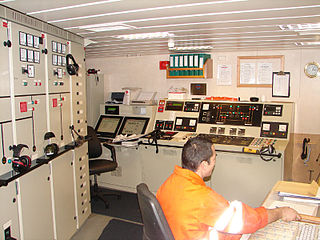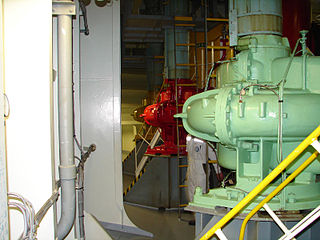Duties and functions
The main duty of a second engineer on board a ship is to schedule and direct maintenance inside the engine room. As the chief may not be able to be in the engine room every day, due to paperwork or meetings, it is the second engineer's responsibility to report on the plant conditions and needs. A second engineer has to be familiar with their ships systems, repair schedules, and test results obtained from oil or water samples.
Each day tasks are typically distributed by the second engineer on what needs to be maintained within the plant and advice is typically given as the second engineer is the most senior engineer on day work. [2] Tasks are typically given in order of seniority or necessity, such as officers receiving more important jobs while non-licensed members receiving a more tedious job. Because of being the most senior engineer on day work, the second engineer must have knowledge of basic systems and be able to work out of technical guides to be able to upkeep machinery to manufacturers specifications. [2]
The first engineer may stand a watch if it is the ship’s protocol or in the event of a manned engine room. With modern technology many engine rooms have become unmanned, but the second engineer must be on call in case an emergency were to occur at any time of day, both at sea and port. [3]
The second engineer reports directly to the chief engineer daily and assists with paperwork and administrative duties as needed. This includes safety checks and duties that the chief may not have time to accomplish.
Uniforms are still worn aboard many ships, especially aboard vessels that may require an officer to interact with passengers, and may differ between companies.
Often when reporting to a vessel the oncoming officer will report to the captain, or officer in charge of the vessel, in dress uniform. In the United States the uniform is in conjunction with Merchant Marine or Merchant Navy standards, depending on company policy. [2] The Merchant Marine uniform distinguishes the First Engineer and the Chief Mate by a propeller on their shoulder boards, or epaulets. It is worn with the propeller closer to the neck and the stripes facing away from the neck, over the shoulders. [3]
During day to day ship operations inside the engine room, engineers will usually wear a work uniform, such as a boiler suit. Often these are thick cotton or denim clothes that are more suited to an engineer's working conditions, but are often subject to company policy. Typically engineers change out of their work clothes in the mess hall to prevent getting oil or dirt from the engine room into the mess hall or galley.

Maritime transport or more generally waterborne transport, is the transport of people (passengers) or goods (cargo) via waterways. Freight transport by sea has been widely used throughout recorded history. The advent of aviation has diminished the importance of sea travel for passengers, though it is still popular for short trips and pleasure cruises. Transport by water is cheaper than transport by air or ground, but significantly slower for longer distances. Maritime transport accounts for roughly 80% of international trade, according to UNCTAD in 2020.

An engine department or engineering department is an organizational unit aboard a ship that is responsible for the operation, maintenance, and repair of the propulsion systems and the support systems for crew, passengers, and cargo. These include the ship engine, fuel oil, lubrication, water distillation, separation process, lighting, air conditioning, and refrigeration.

The United States Merchant Marine is an organization composed of United States civilian mariners and U.S. civilian and federally owned merchant vessels. Both the civilian mariners and the merchant vessels are managed by a combination of the government and private sectors, and engage in commerce or transportation of goods and services in and out of the navigable waters of the United States. The Merchant Marine primarily transports domestic and international cargo and passengers during peacetime, and operate and maintain deep-sea merchant ships, tugboats, towboats, ferries, dredges, excursion vessels, charter boats and other waterborne craft on the oceans, the Great Lakes, rivers, canals, harbors, and other waterways. In times of war, the Merchant Marine can be an auxiliary to the United States Navy, and can be called upon to deliver military personnel and materiel for the military.

The United States Merchant Marine Academy is a United States service academy in Kings Point, New York. It trains its midshipmen to serve as officers in the United States Merchant Marine, branches of the United States Armed Forces and the transportation industry. Midshipmen are trained in different fields such as marine engineering, navigation, ship's administration, maritime law, personnel management, international law, customs, and many other subjects important to the task of running a large ship.
Texas A&M University at Galveston (TAMUG) is an ocean-oriented branch campus of Texas A&M University offering both undergraduate and graduate degrees. Students enrolled at Texas A&M University at Galveston, known affectionately as 'Sea Aggies', share the benefits of students attending Texas A&M University (TAMU) campus in College Station. TAMUG is located on Pelican Island, offering benefits for its maritime focused majors.

A chief mate (C/M) or chief officer, usually also synonymous with the first mate or first officer, is a licensed mariner and head of the deck department of a merchant ship. The chief mate is customarily a watchstander and is in charge of the ship's cargo and deck crew. The actual title used will vary by ship's employment, by type of ship, by nationality, and by trade: for instance, chief mate is not usually used in the Commonwealth, although chief officer and first mate are; on passenger ships, the first officer may be a separate position from that of the chief officer that is junior to the latter.

A third mate (3/M) or third officer is a licensed member of the deck department of a merchant ship. The third mate is a watchstander and customarily the ship's safety officer and fourth-in-command. The position is junior to a second mate. Other duties vary depending on the type of ship, its crewing, and other factors.

Watchkeeping or watchstanding is the assignment of sailors to specific roles on a ship to operate it continuously. These assignments, also known at sea as watches, are constantly active as they are considered essential to the safe operation of the vessel and also allow the ship to respond to emergencies and other situations quickly. These watches are divided into work periods to ensure that the roles are always occupied at all times, while those members of the crew who are assigned to work during a watch are known as watchkeepers.
Seafaring is a tradition that encompasses a variety of professions and ranks. Each of these roles carries unique responsibilities that are integral to the successful operation of a seafaring vessel. A ship's crew can generally be divided into four main categories: the deck department, the engineering department, the steward's department, and other. The reasoning behind this is that a ship's bridge, filled with sophisticated navigational equipment, requires skills differing from those used on deck operations – such as berthing, cargo and/or military devices – which in turn requires skills different from those used in a ship's engine room and propulsion, and so on.

An engineering officer or simply engineer, is a licensed mariner qualified and responsible for operating and maintaining the propulsion plants and support systems for a watercraft and its crew, passengers and cargo. Engineering officers are usually educated and qualified as engineering technicians.
A fourth engineer or third assistant engineer is the most Junior engine officer in the engine department of a merchant vessel.

A chief engineer, commonly referred to as "Chief" or "ChEng", is the most senior licensed mariner of an engine department on a ship, typically a merchant ship, and holds overall leadership and the responsibility of that department. Chief engineer's rank is equivalent to the rank of a ship's captain. As a person who holds one of the most senior roles on the ship, they must have excellent communication and leadership skills. They will be expected to regularly work alongside other crew members and external consultants, and most importantly, provide guidance to their team.

An oiler is a worker whose main job is to oil machinery. In previous eras there were oiler positions in various industries, including maritime work, railroading, steelmaking, and mining. Today most such positions have been eliminated through technological change; lubrication tends to require less human intervention, so that workers seldom have oiling as a principal duty. In the days of ubiquitous plain bearings, oiling was often a job description in and of itself.

A wiper is a position responsible for both cleaning the engine spaces and machinery of a ship and assisting the ship's engineers as directed. Railroad workers who performed similar jobs were also known as wipers, or in the UK as "cleaners".

A licensed mariner is a sailor who holds a license from a maritime authority to hold senior officer-level positions aboard ships, boats, and similar vessels. Qualification standards for licensed mariners are universally set by the STCW Convention adopted and promulgated by the International Maritime Organization (IMO), while the licenses of individual sailors are issued by the delegated maritime authorities of the member states of the IMO; these may vary in the details of the implementation, including the government agency responsible for licensing and the local names of the grades and qualifications in each particular country.

A pumpman is an unlicensed member of the Deck Department of a merchant ship. Pumpmen are found almost exclusively on tankers, and on oil tankers in particular. Variations on the title can include chief pumpman, QMED/pumpman, and second pumpman.

A sailor, seaman, mariner, or seafarer is a person who works aboard a watercraft as part of its crew, and may work in any one of a number of different fields that are related to the operation and maintenance of a ship.
The California Maritime Academy Corps of Cadets is the undergraduate student body at the California Maritime Academy. As a State Maritime Academy, as required by Title 46 Part 310 of the Code of Federal Regulations students are considered Cadets, required to wear uniforms, and utilize a demerit-based disciplinary system. Participation in the Corps of Cadets is mandatory; participation in the Navy Reserve Merchant Marine program is optional. Cadets still utilize Merchant Marine Navy-style uniforms, customs, and traditions. Based on academic majors cadets are organized into Squads, Sections, Divisions and Companies which regularly muster in Morning Formations multiple times a week, as well as stand watches on campus and aboard the training ship.

The Electro-Technical Officer (ETO) is a licensed member of the engine department of a merchant ship as per Section A-III/6 of the STCW Code.
Nautical operations refers to the crew operation of a ship. It is the term used in academic education to refer to the studies of this professional field. Nautical operations refers to all the operational procedures, specific roles of officers and crew members, and regular functions and technical processes, which together shape the structure and functions for the general operations of a ship.














